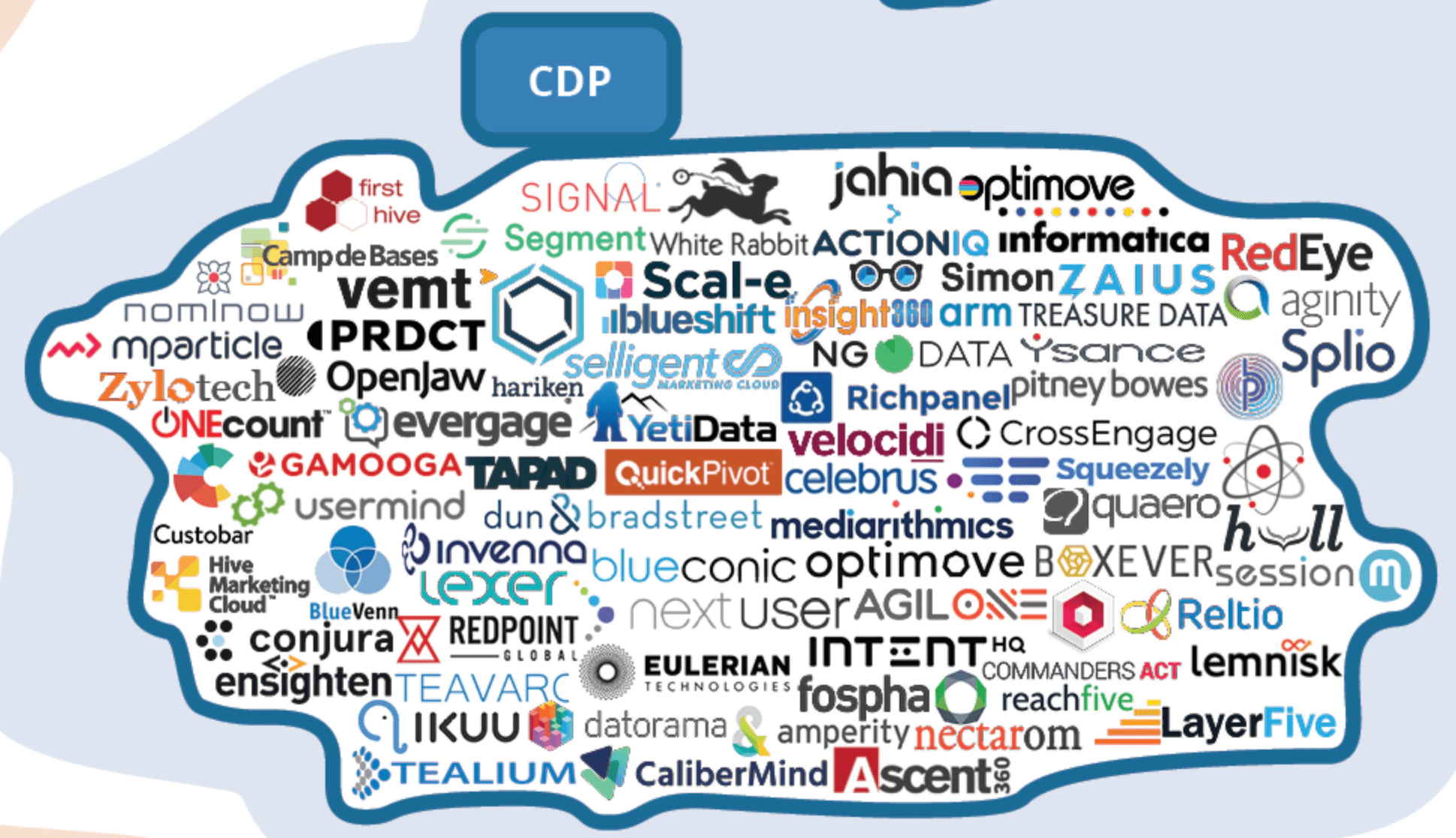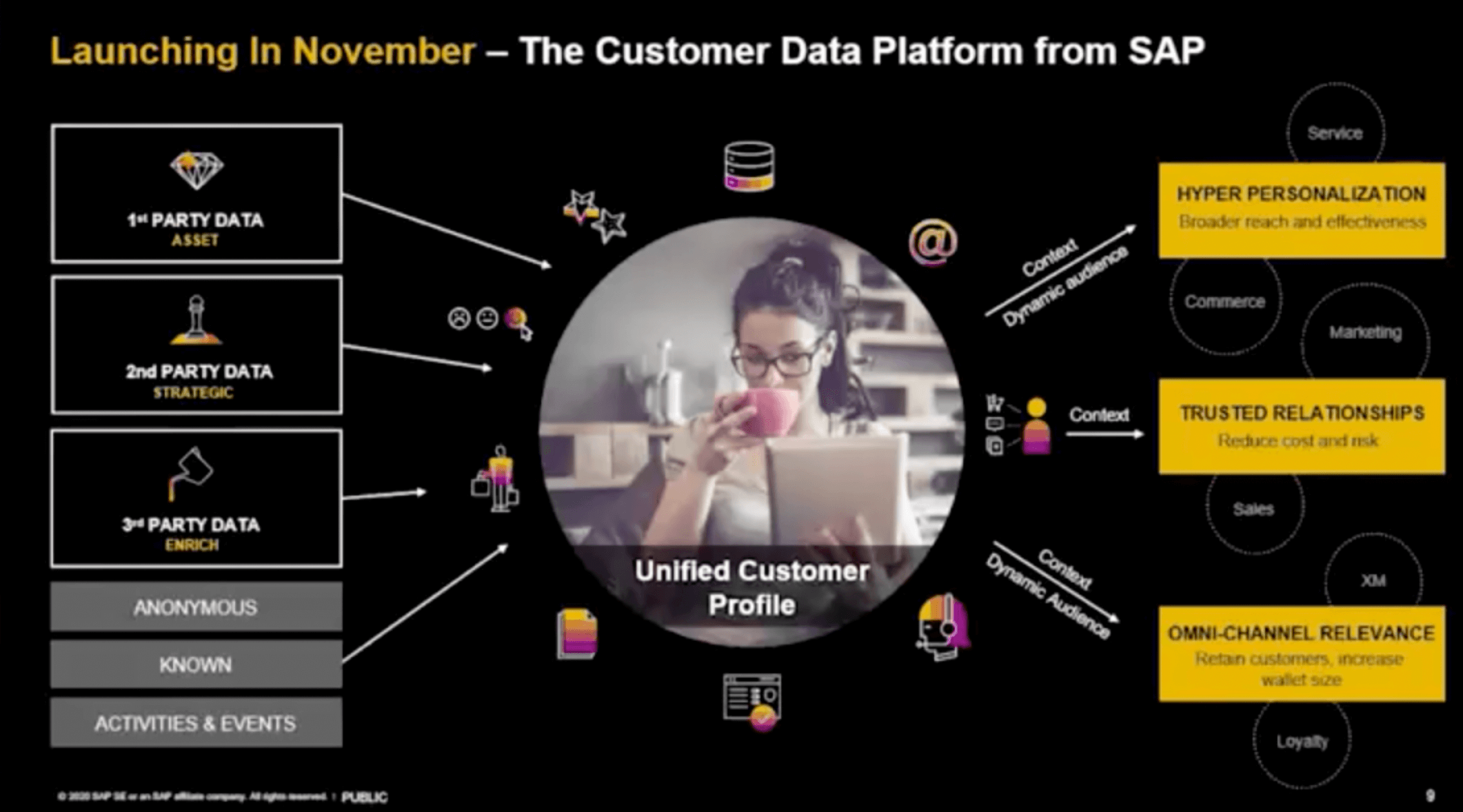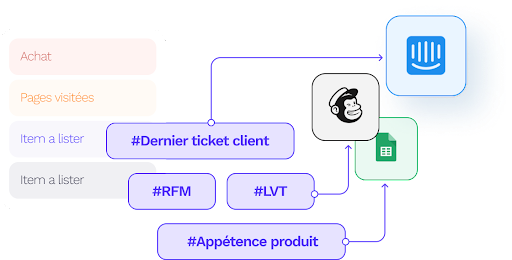The CDP market is difficult to comprehend There are two main reasons for this.
The first reason is that there are more than 100 players and new entrants regularly appear. To qualify this, it should be noted that we are beginning to see a phenomenon of concentration (= takeovers) typical of markets that are becoming mature.
The second reason is that the offer is segmented. The generic term “CDP” actually hides very heterogeneous technical solutions. A CDP is used to connect, unify and activate customer data, but there are several ways of doing this and therefore several types of CDP. The functional scope can vary enormously from one solution to another.
How do you find your way around? How do you make the right choice? We will help you to see this more clearly.
In our opinion, there are three main types of CDP, and we will define and qualify them. But first, let’s go back to the origins of the CDP, you’ll see that it’s a good entry point to understand the Customer Data Platforms market.
| Martech Suite | Engagement-oriented CDP | Data Management oriented CDP |
|---|---|---|
| CDP offerings from leading martech tool vendors are integrated within a suite of tools, rather than being an independent software layer. | CDP's "pure players" focus more on activation and/or engagement (self-service segmentation, journey orchestration, personalisation, marketing campaigns, etc.). | CDP editors who focus more on data management aspects (ingestion, profile unification, data cleansing, stewardship, identifier resolution, etc.) |
| Salesforce, Adobe, Microsoft, SAP, ... | Segment, Tealium, Blueshift, CrossEngage, etc. | Octolis, mParticle, NG Data, Treasure Data, etc. |
📕 Summary
The origin of CDP platforms helps to understand their differences

Overview of CDP market players. Source: chiefmartec.
Let’s start with the classic definition of a CDP: “A CDP is a marketing solution that unifies the company’s customer data from marketing and other channels to obtain a modelled view of the customer and optimise the timing and targeting of messages and offers”. This is the definition proposed by Gartner.
A CDP connects your customer data and unifies it around a customer ID to give you the ability to better leverage it.
But there are many approaches to fulfilling this function, and therefore many types of CDP. Here’s a bit of history to help you understand the fragmentation of the CDP market.
CDPs have two main origins: some are former DMPs, others are MarTech solutions (such as CRM) that have enhanced their offering to become CDPs.
#1 DMP Solutions & Tag Manager solutions
CRM software was the first software used to manage customer data and came onto the market in the 1990s, allowing companies to centralise (at least partially) the management of customer interactions. CRMs have gradually integrated the new online channels: email, website, social networks, etc. Conceived as activation tools, CRMs were in fact used from the start to centralise customer data, as a Customer Data Management solution.
Then came DMPs in the early 2000s: Data Management Platforms. A Data Management Platform is a solution for managing online advertising campaigns and creating targeted audiences by using anonymous online data (cookies). The DMP essentially manages “third party” online data, i.e. not collected by the users of the DMP (the advertisers), but by third party platforms and services.
DMPs were very fashionable in the mid-2010s. The development of RTB is the main cause of this craze. As a reminder, RTB refers to real-time programmatic advertising, which allows retargeting of internet users based on their web searches – the cost of the ads (CPC/CPM) being calculated in real time based on a bidding system.
The euphoria for DMPs has subsided, for several reasons:
- The GDPR limits the ability to leverage anonymous behavioural data.
- The Return on Investment (ROI) of DMP projects is often quite low…
- DMPs are often diverted from their primary function: they are used to cross-reference CRM data with anonymous data (CRM Onboarding).
As a result, many DMPs or web tracking solutions have evolved to focus on personal data and have positioned themselves no longer as a “Data Management Platform” but as… “Customer Data Platform”. Examples include Segment, Eulerian and Commander Act.
The CDP market therefore has its origins, at least in part, in the DMP market.
#2 Martech solution publishers who have an offer in response to market developments
The big MarTech suite vendors (Adobe, Salesforce, Microsoft, Oracle, SAP…) have all launched a CDP offering. Salesforce launched the pilot version of its CDP in 2019 (Source), as did Adobe which unveiled its CDP in the same year (Source). The launch of the SAP CDP was announced with great fanfare in November 2020 (Source).

Slide presentation of the launch of SAP CDP in November 2020.
The strategic stakes for these publishers are high. If companies have an independent CDP, they will be much more inclined to use marketing tools from different publishers and to change tools. The strength of these major MarTech publishers is that they offer suites made up of dozens of software applications that respond to all of their customers’ business problems. These are ecosystems. To keep their customers locked into the ecosystem, these ecosystems must include a CDP brick.
Mid-sized CRM/marketing publishers are also beginning to offer CDP solutions that are more or less independent of their main solution. This is the case, for example, of NP6, which has developed a CDP following the acquisition of the DMP Ezakus. Selligent also offers a CDP.
CDP typology
To understand the CDP market, it is important to understand that there are three main types of CDP:
- CDPs offered by large MarTech vendors.
- CDP oriented “engagement”, marketing.
- The “data management” oriented CDP.
#1 CDP proposed by the large Martech publishers
We have seen that all the large MarTech publishers, Salesforce, Oracle and Microsoft, have launched a CDP offer in reaction to the development of a market that could be harmful to them.
The CDPs offered by MarTech publishers can be either Engagement or Data Management oriented, even if, in fact, it is the first orientation that is more frequent.
The common feature of these CDPs is that they are designed as technological “bricks” integrated into the software suite offered by the vendor. If you choose the Salesforce CDP, your Customer Data Platform will not be an independent database but rather a separate software layer from the other tools. Choosing the Salesforce CDP is in fact choosing the Salesforce ecosystem. This type of CDP creates a de facto dependency on the publisher. The advantage is that the connection between the different bricks of the suite is simple and optimised. The disadvantage is that you are strongly encouraged to choose the tools of the suite proposed by the publisher.
If you are already largely in a Salesforce environment (for example), it may make sense to opt for the Salesforce CDP. On the other hand, if you are in a “Best of Breed” perspective and you want your CDP to be independent of your software, then this is not the option to choose. Finally, it should be noted that the CDPs offered by the large MarTech publishers are on average the most expensive.
Some examples of CDPs offered by MarTech publishers and integrated into their software suite
- Salesforce
- Microsoft
- SAP
- Adobe
- Oracle
#2 CDPs that are “engagement ” oriented
We could also say “customer experience oriented”, “marketing oriented”, “omnichannel orchestration oriented”. As you will have understood, “engagement” oriented CDPs are solutions offered by independent and specialised publishers that enable better activation and “engagement” of customers: dynamic segmentation, orchestration of customer relations at all stages of the customer journey, marketing personalisation, website personalisation, marketing campaign management, marketing automation, real-time interactions, product recommendations, etc.
These are powerful marketing solutions dedicated to enriching the customer experience and improving marketing and sales performance. The “activation” layer is very strong in terms of operation. The “data management” layer is limited: the depth of BDD functionality is sometimes limited. Your CDP, in this case, is a tool before being a database.
CDPs of this type have an enabling role. They are not only used to unify data and transform data, they are also directly used to activate its data on the different channels and customer touch points. This is an important point to emphasise because CDPs are generally designed primarily as customer data laboratories.
For example, they produce segments or scores from the unified data and redistribute them to the classic activation tools: CRM, marketing automation, customer service, ecommerce, social media management, etc. Engagement-oriented CDPs are in fact all-in-one platforms and represent the largest family of CDPs in terms of the number of players.
Some examples of engagement-oriented CDPs offered by independent publishers
- Tealium
- BlueVenn
- Segment
- Optimove
- Lexer
- QuickPivot
- Lemnisk
#3 Data management-oriented CDPs
There is one last type of CDP: the data management-oriented Customer Data Platforms. As the name implies, these CDPs aim to connect, unify and transform the customer data that is scattered throughout your organisation. The unified data is enriched and used to create segments, perform calculations, build aggregates and scores to feed the various business software: the CDP, Marketing Automation, ticketing software, etc.
Data management-oriented CDPs are not activation solutions. They organise, unify and enrich customer data, which is then redistributed in the form of aggregates to classic activation tools.
Connection, unification of data around a consistent customer profile (360° customer view), data cleansing, normalisation, deduplication, ID resolution: these are some of the key functionalities of a data-driven CDP. Data-driven CDPs are used to build a Single Customer Repository (SCR).
Customer data unified through data-driven CDPs is :
- Either stored in your CDP**. In this case, your Customer Data Platform also acts as a database. It is a storage AND computing solution.
- Or stored in the company’s cloud datawarehouse**. In this case, your CDP is a software layer connected to the data warehouse.
A few examples of CDPs with a data management focus:
- Octolis
- Treasure Data
- Celebrus
- mparticle
- Amperity.
There are several sub-categories within this large family of data management CDPs: anonymous data-centric CDPs, intelligence-centric CDPs and finally datawarehouse-centric CDPs.
Anonymous data-centric CDPs
Some CDPs are designed to manage mainly anonymous data, i.e. engagement and web behaviour data relating to Internet users whose identity is not known (name, first name, email, etc.). This is typically the data obtained through cookies and used to create retargeting campaigns on digital channels.
CDPs that are natively designed to manage anonymous data are in fact software initially positioned as tracking solutions or Data Management Platforms (DMP). We refer you to what we said in the introduction to this article. At a time of RGPD and restrictions on the use of non-first party data, the future of these DMPs is compromised. In any case, they will have to reinvent themselves.
Intelligence-centric CDPs
These CDPs, always data-centric, offer advanced functionalities for data enrichment and segmentation. They are also sometimes referred to as “CDP analytics”. These CDPs are the ultimate tools for Customer Knowledge and are used to create dynamic segments, implement predictive scoring or enrich the database with new calculated fields. These CDPs, which can be boosted with AI (machine learning, predictive modelling), put intelligence into the database in order to redistribute high value-added data and segments to the activation tools.

Examples of calculated fields that Otolis allows you to use from your business tools.
Some CDPs in this sub-category allow you to create predictive scores on the shelf (Advalo), others allow you to easily add calculated fields and scores (Octolis).
Datawarehouse-centric CDP
This category refers to the distinction we made earlier: either the data is stored in your CDP (the CDP then acts as a DB) or the data is stored outside your CDP, i.e. in your cloud datawarehouse or system acting as a data warehouse, a central data base.
Datawarehouse-centric CDPs are software solutions that share the following characteristics:
- They do not store customer data.
- They are connected to the system that acts as the DB: the data warehouse.
This means that your data stays in your datawarehouse, where it is safe and sound. This is the optimal solution to keep full control of your data.
- *Your CDP = your datawarehouse
What if you use your cloud datawarehouse as a Customer Data Platform? More and more organisations are opting for this option, attracted by the flexibility of this architecture and the maximum control over data it offers. Read our full article on the subject.
Despite the wide variety of CDP offerings, clear lines of differentiation are emerging. CDPs can be distinguished according to two criteria:
- Whether or not they belong to a suite: CDPs developed by major publishers vs. CDPs developed by independent and specialised publishers
- According to their primary purpose: marketing orchestration or data management.
The direction of history seems to point towards light CDPs oriented towards data management and datawarehouse-centric. This new generation of CDPs is the one that best fits into the modern data stack, the backbone of which is the cloud datawarehouse. The limitations of the CDPs proposed by the major publishers are beginning to be perceived: lack of control over the data, confinement in a closed ecosystem, pricing model often disadvantageous for companies. For further discussion, we invite you to read our article “Towards a new paradigm in the Customer Data Platforms market“.


